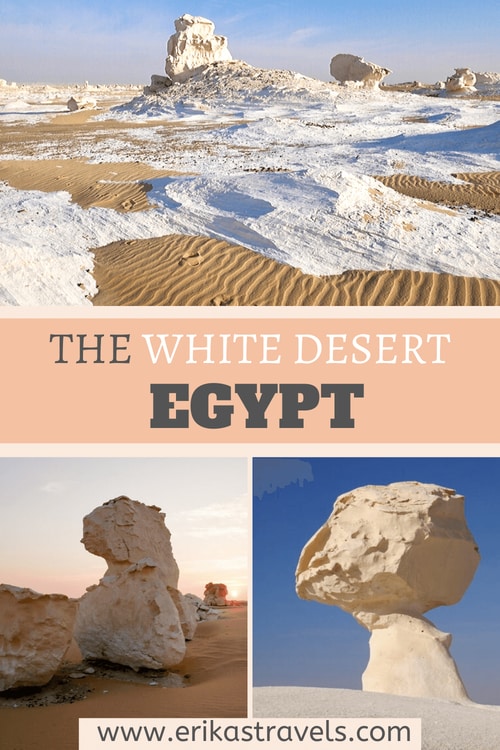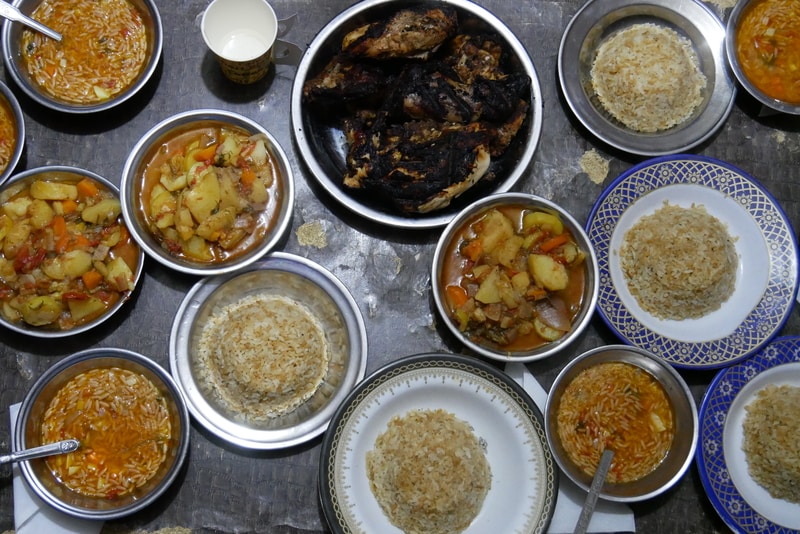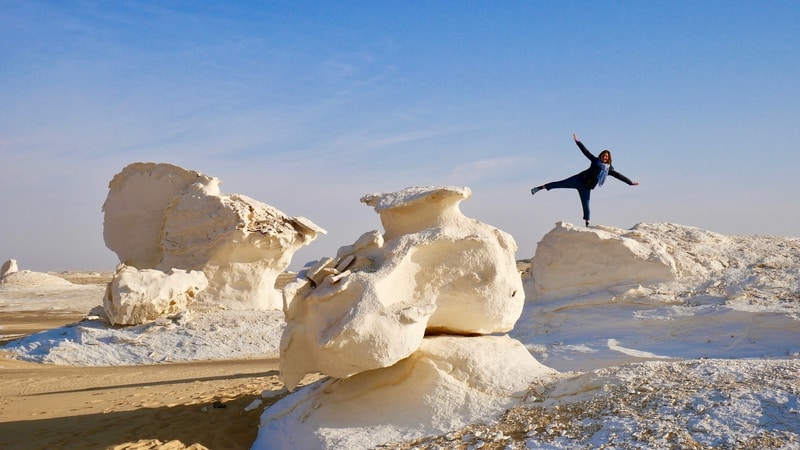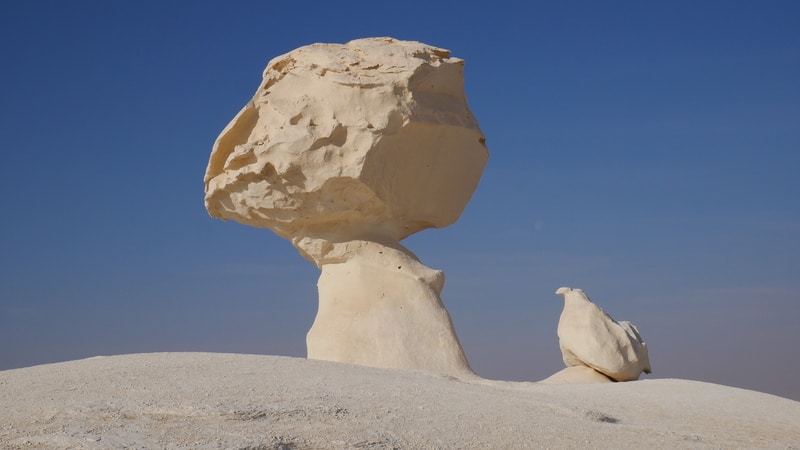
White Desert Tour in Western Egypt
Egypt is full of bucket list attractions: the Pyramids of Giza, the Great Sphinx, the Valley of the Kings, and the Egyptian Museum, to name a few. These archeological sites reveal an ancient history of unrivaled richness that has greatly influenced the world we live in today.
Yet, while most tourists visit Egypt for its historical treasures, the country’s natural wonders are equally captivating. Experiencing Egypt’s White Desert on an overnight tour reveals a landscape draped in mystery and intrigue, where nature’s delicate geologic formations rival some of the country’s greatest human-engineered creations.
THE WHITE DESERT IN EGYPT
The White Desert lies roughly 175km southwest of the Bahariya Oasis. It is the crown jewel of Egypt’s Western Desert, and one of the most distinctive natural landscapes in North Africa. Characterized by its brilliant chalk spires that resemble icebergs in a sea of sand, it a vast and barren expanse of elemental beauty.
The White Desert’s ethereal rock formations sprout almost supernaturally from the ground. Like clouds, they take on shapes both familiar and unfamiliar—sculpted by desert winds over millennia.
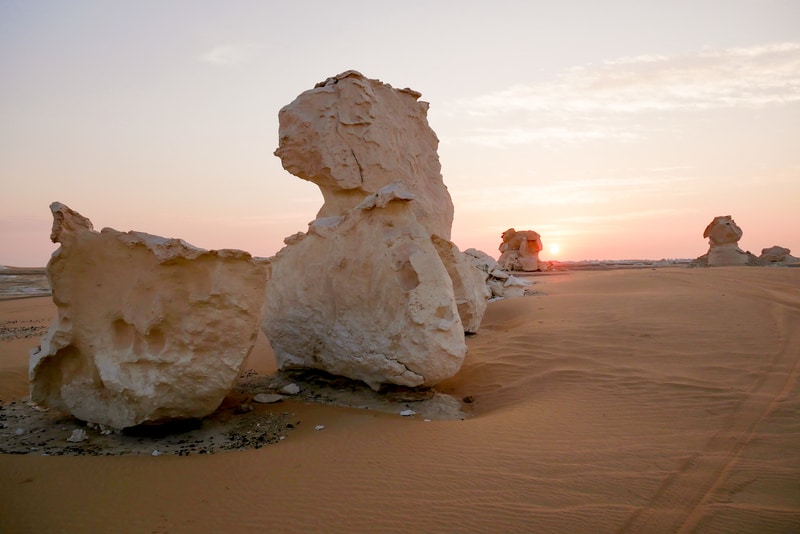
The White Desert itself is the highlight of many overnight tours to Egypt’s Western Desert, but it is by no means the only place to visit in the area. All around, the parched landscapes of western Egypt give way to lunar topographies and otherworldly views.
WHITE DESERT TOUR WITH DAHAB HOSTEL
We chose to book a White Desert tour with Dahab Hostel, despite the frustrations we experienced with their Nile River cruise. At only $85 per person, the price of the overnight desert tour was simply unbeatable.
Our tour included shared transport to the Bahariya Oasis, lunch at a hotel, jeep transport into the Black and White Deserts, a barbecue buffet dinner, and a night of camping under the area’s scintillating blanket of stars.
GETTING TO THE WHITE DESERT
Like mashrutkas in Eastern Europe, trotros in Ghana, and combis in Southern Africa, cramped minivans that leave when full are a popular mode of transport in Egypt. We soon learned that Dahab Hostel’s low tour price is due—in large part—to the fact that it uses this popular form of local transport for travel between Cairo and the Bahariya Oasis.
On the day of our departure, we woke up early and caught a taxi to the minibus station. There, we waited for the desert-bound minivan to fill with passengers. But the slow trickle of people caused us to wait for more than two hours, with no sign of the van filling up.
Finally, afraid that we would miss all the best daylight hours of our tour, Dan and I paid an extra $10 per person and convinced the driver to leave early.
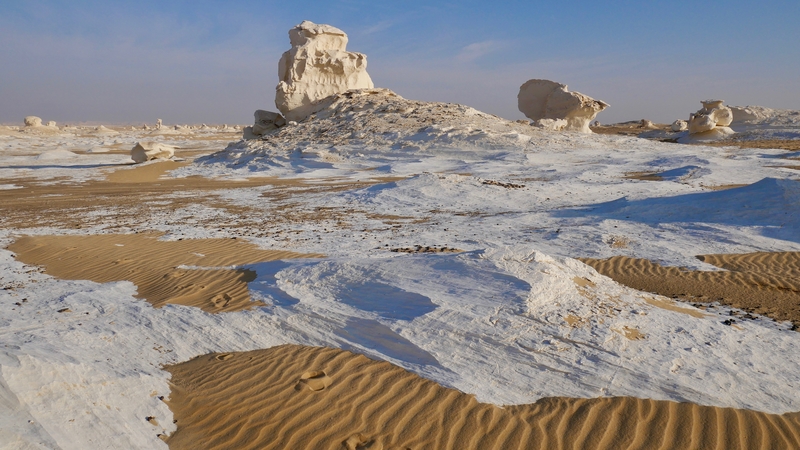
If your Egypt budget allows, I recommend shopping around for White Desert tour options. Most other companies offer private 4X4 transport between Cairo and Bahariya. They are, however, significantly more expensive.
Since Dan and I each saved over $100 by taking a tour with Dahab Hostel, we were happy to shell out a few extra dollars in order to expedite our trip to the Bahariya Oasis. We figured that the earlier we made it to our destination, the more time we would be able to spend in the Black and White Deserts.
THE BAHARIYA OASIS
The Bahariya Oasis itself was not a part of our White Desert tour itinerary. From the limited time I spent in the area, I could tell it was worlds away from Cairo. About 35,000 people live in Bahariya. The population is mostly Beduin, and largely conservative. Few women roam the streets, and most of those that do are clad in black from head to toe.
Once we arrived in Bahariya, we met our guide and transferred to the Ahmed Safari Camp for lunch. There, we teamed up with five other travelers for an unforgettable overnight adventure into one of the most geologically interesting swaths of the Sahara.
THE BLACK DESERT
The desert around the Bahariya Oasis is flat, bleak and uninspiring. About 50km south of the oasis, however, a change in the desert floor’s textures and colors signals the beginning of the Black Desert.
Egypt’s Black Desert looks as though it has been torched from the area’s intense summer sun.
When we reached the charred landscape, our tour guide let us out of the car for about 20 minutes and suggested we scramble up one of the area’s conical peaks.
From our elevated vantage point, we could see hundreds of ebony-plated peaks extend skyward, interrupting the monotony of their beige surroundings.
CRYSTAL MOUNTAIN
From the Black Desert, we continued onward, to Crystal Mountain—a massive rock made entirely of quartz. The sparkly hunk of rock lies just off the main road and is a popular attraction on Egypt desert tours.
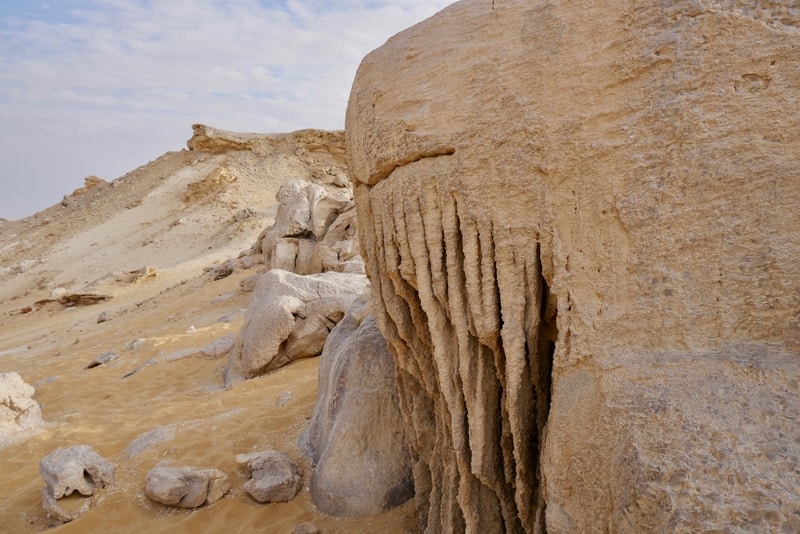
As with the Black Desert, our 20 minute pitstop at Crystal Mountain gave us minimal time to explore the area.
Regardless, found enough time to scramble up the mountain, examine its unique sparkly surface, and revel in our gold-tinted Wadi-Rum-like environs.
THE AGABAT VALLEY
From Crystal Mountain, our 4×4 jeep turned off the main road and pummeled over the sand, up a mountainside, and into the Agabat Valley.
When we reached Agabat, Dan and I gasped in unison. We immediately began to understand the spell that Egypt’s desert landscapes cast on travelers.
A vast panorama of dunes swirled around the base of gold-colored monoliths. patches of white chalk scattered among the sand like dollops of freshly whipped cream. It was magical. Enchanting. Breathtaking.
And unlike the Pyramids of Giza or the archeological sites that we visited up and down the Nile, the Agabat Valley in Egypt’s Western Desert was remarkably crowd-free.
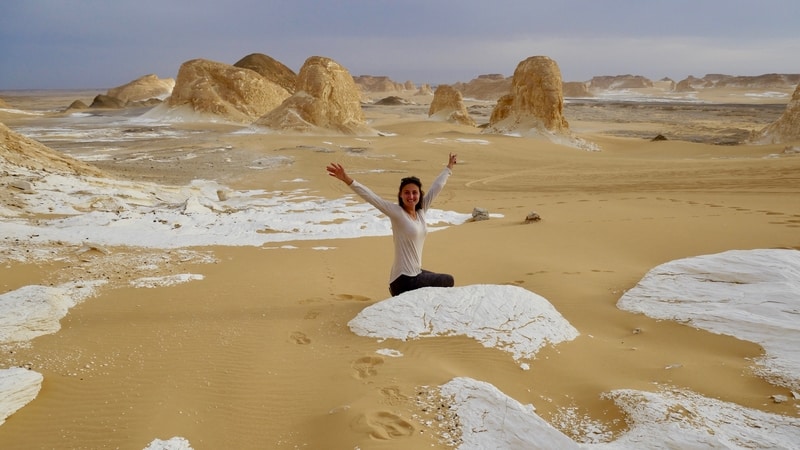
The driver of our 4×4 vehicle navigated the deep sands of the Agabat Valley like a seasoned professional.
I was beginning to realize that—despite its apparent disorganization at the start—our tour to the White Desert with Dahab Hostel was turning out to be an undeniable highlight of our Egypt itinerary.
WHITE DESERT ROCK FORMATIONS
The classic landscapes of Egypt’s White Desert begin beyond the Agabat Valley. Here, far from civilization, a forest of chalk spires rises from the Earth’s sandy surface in a whimsical display of nature at its best.
The rock formations of the White Desert in Egypt are textbook examples of ventifact. This phenomenon occurs when wind blows sand particles a few feet above the earth. Over time, the bouncing sand grains erode the lower portions rock, while leaving larger caps.
Like children trying to determine the shapes of clouds, Dan and I found ourselves peering out the car window and calling out the shapes of rocks as they zoomed past us. Some chalk spires resembled animals, others looked like people. Some resembled pillow-top mushrooms, others reached toward the sky like amorphous lopsided blobs.
CAMPING IN THE WHITE DESERT
As we reached the White Desert, the setting winter sun cast shadows over the landscape. I was grateful that we arrived in the area in time for sunset. I was even able to capture a few photos of my surroundings before the sky faded to black.
Meanwhile, our guide set up camp. He cooked us a delicious meal—one of the best we had during our entire monthlong trip through Egypt and Sudan—and kept a fire going for much of the night.
A few other White Desert camping tour groups were scattered about the distance, but we were otherwise completely isolated.
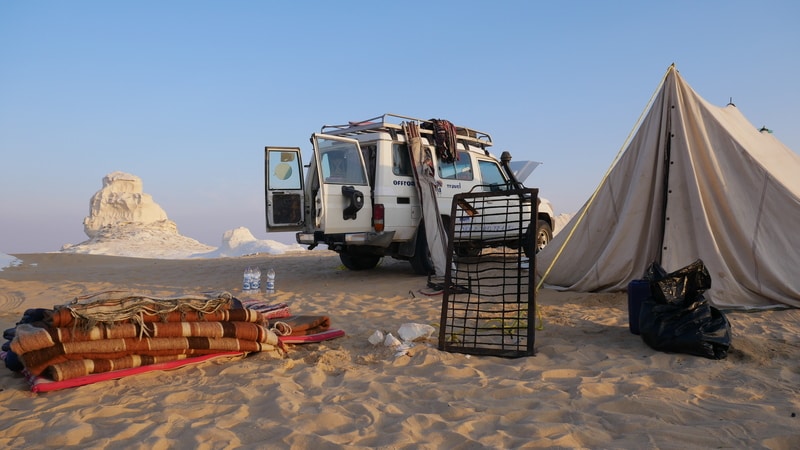
Since I’d heard many traveler’s rave about the stars in western Egypt, I was initially disappointed that we visited the White Desert during a full moon. I feared that increased light would drown out the stars.
But as it turns out, visiting during a full moon is magical in its own right. I wager it might even be more magical than seeing the area under a blanket of stars.
For on full moon nights, the desert’s chalk formations shine in the darkness like glow-in-the-dark mushrooms. They illuminate the surrounding landscape long after nightfall—making it possible to explore the surreal landscape even hours after the sun has set.
IS THE WHITE DESERT SAFE FOR VISITORS?
On a whole, the Black and White Deserts in Egypt are safe for visitors.
However, because of instability in neighboring Libya, there is still a low risk of crime and kidnapping in the area. The Egyptian army has little control over the vast stretches of land west of Cairo.
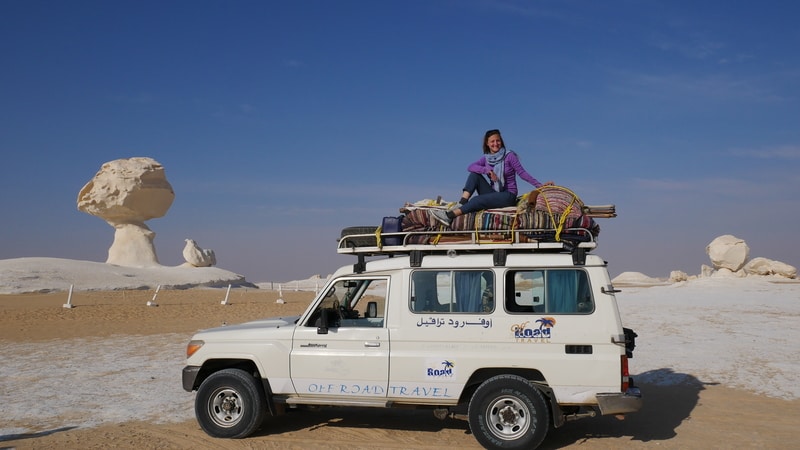
I have no reservations in recommending Western Desert tours, as travelers are unlikely to encounter problems in the area.
As always, however, I encourage you to stay up to date with current advisories and take normal precautions.
****
Egypt’s historical and archeological gems are undeniable. They represent some of the most iconic and beloved tourist attractions on Earth.
Yet, our tour to the Black and White Deserts in Egypt’s western reaches, proves that—in addition to housing human-made treasures of great importance—the country is home to natural wonders that are older than the pyramids and as sublime as any temple.
____________________________________
Did You Enjoy this Guide To Egypt’s White Desert? Pin It!
